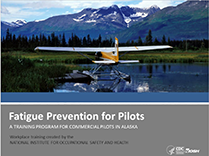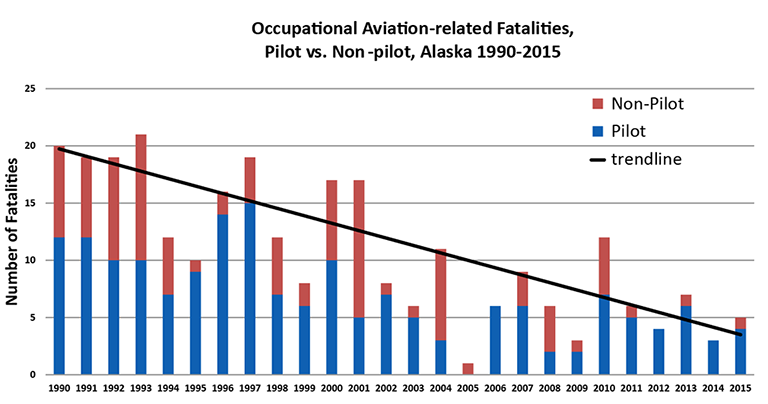Aviation Safety Research Program
Aviation Product Spotlight

Fatigue Prevention for Pilots: A Training Program for Commercial Pilots in Alaska (NIOSH Pub. #: 2016-162)
The NIOSH Aviation Safety Research Program has created a training program to educate pilots on fatigue prevention. The training can be downloaded here: Fatigue Prevention for Pilots: A Training Program for Commercial Pilots in Alaska.
Hard copies are available at no cost by emailing aviation@cdc.gov
Projects and Outcomes
Resources

Scenes showing common uses of aviation in Alaska; workers load a Cessna 207, view from a Robinson R44 helicopter and a De Havilland DHC-3 landing in Juneau.
Alaska is uniquely dependent upon air transportation. Commuter and air taxi operators serve as the main link to much of Alaska, transporting people, cargo, and mail to more than 250 villages located off of the road system, that’s over 80% of the towns and villages in Alaska. This critical mode of transportation can be hazardous. View a video about the Alaska Aviation Lifeline . The content of the video is also available on YouTube .
A disproportionate number of commuter and air taxi accidents occur in Alaska. During 1990-2015 there were 1,874 commuter and air taxi accidents in the United States. Commuter and air taxi accidents in Alaska accounted for more than one-third of those events and more than 20% of the fatal events and deaths in the U.S.
|
Commuter and Air Taxi Accidents† 1990-2015 |
||
|
|
U.S. Accidents |
Alaska Accidents |
|
Number of events |
1874 |
674 (36%*) |
|
Number of fatal events |
454 |
96 (21%*) |
|
Number of fatalities |
1296 |
279 (22%*) |
†Defined as Federal Aviation Regulations Part 135 flights, accidents defined as by 49 CFR Part 830.
* Percent of all U.S. commuter and air taxi accidents.

Graph showing Occupational Aviation-related Fatalities, Pilot versus Non-pilot, Alaska 1990-2015.
Aviation is a hazardous mode of transportation for pilots and passengers alike. During 2000-2015, non-military aviation events in Alaska caused fatal injuries to 46 workers who were in or around aircraft as part of their jobs. During this same time period, 76 occupational pilot deaths occurred (excluding military), an average of 5 pilot fatalities per year, compared to an average of 10 pilot fatalities per year during 1990-1999. These 76 fatalities over 16 years from a commercial pilot workforce of approximately 2,600 results in an annual pilot fatality rate of 183 per 100,000 pilots. While this is an improvement from the 1990s, it is still almost 50 times the fatality rate for all U.S. workers and more than twice the occupational fatality rate for all U.S. pilots. For more information on safety improvements in Alaska, please see our fact sheet or read the article.
NIOSH continues to work to reduce Controlled Flight into Terrain accidents , prevent mid-air collisions and provide fatigue awareness and education for pilots to improve aviation safety for workers in Alaska.
- Page last reviewed: December 29, 2016
- Page last updated: December 29, 2016
- Content source:
- National Institute for Occupational Safety and Health Office of the Director


 ShareCompartir
ShareCompartir